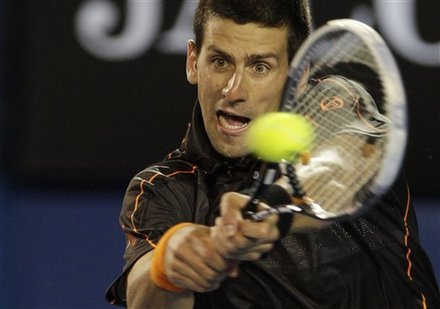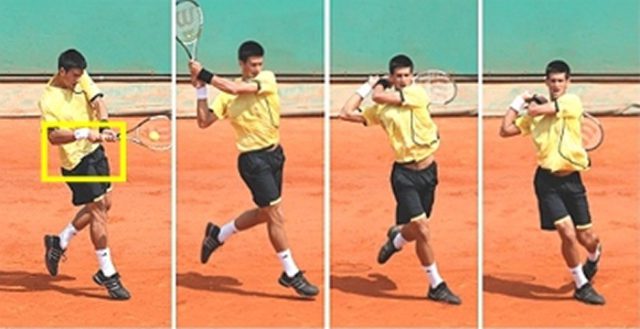The Novak Djokovic backhand technique is hailed as one of the top two handed backhands on tour.
Novak Djokovic Backhand: Foundation to the Game
Serbian world number one Novak Djokovic is putting up one of the most dominant seasons in the history of men’s tennis. To date, this 2011, he has lost only one match. A major key to his success is his all-around game that features absolutely no weaknesses. But it wasn’t always that way. He used to be fragile and easily fatigued. People questioned his fighting spirit. But there was part of his game that had been there all along. It was the Djokovic backhand.
When Roger Federer was thoroughly dominating men’s tennis, tennis fans were looking desperately for someone to challenge the greatness of the Swiss maestro. Federer was a beloved champion, but tennis needed someone to play the role of challenger. Rafael Nadal, who would go on to dominate Federer on the clay courts, wasn’t good enough yet to get to the finals of the biggest hard court events in order post a serious challenge for the top ranking.
In 2007, a young and ambitious Djokovic was scheduled to meet Federer in the 4th round of the Australian Open. Amazingly, he proclaimed that he was targeting the world number one ranking. How dare he be so brazen if even Nadal was way behind Federer in terms of ranking points? People thought he was all talk as he lost that match.But the keenest observers knew he was on to something. He had the talent and the game that could potentially be developed further.
Novak Djokovic Backhand Technique
The foundations were already there and the Djokovic backhand was one of its bedrocks. Novak quickly learned from that experience. Later that summer, he became the first player to beat both Nadal and Federer to win a Masters Series event. He was also runner up to Federer at the US Open where fans got to see his humorous personality. He was aptly nicknamed the Djoker.
But he proved that he was more than just a funny guy. At the Australian Open in 2008, he upset Federer in the semi-finals and went on to win the tournament for his first grand slam title. Still, there were lingering issues regarding his endurance and mental fortitude.
Never one to give up a dream, he constantly searched for ways to improve his weaknesses. He consulted people on how he could change his diet, his training, his strokes and his psychological approach to the game. Little by little and sometimes by learning through trial and error, he improved.
Key to Success Behind the Novak Djokovic Backhand
All the while, the Djokovic backhand remained as solid as ever, with the rest of his game rapidly catching up. By the end of 2010 he had reached another grand slam final, losing the US Open championship to Nadal. He then led his nation to the Davis Cup and it was then when he truly took flight.


Like all of the top players of recent times, Djokovic is an aggressive baseliner. He is the modern version of past baseliners like Ivan Lendl and Andre Agassi.
The main difference between him and the older generation is his ability to transition from defence straight to offense with just one big shot. This has been the hallmark of every great player in the past 10 years or so.
It certainly defined the playing ability of his rival Nadal. But whereas Nadal was clearly stronger from the forehand than from the backhand, the Djokovic backhand is every bit as lethal as his forehand.
The secret to Djokovic’s current success is that he is really the first player who has ever had absolutely no weaknesses. It was previously thought that Federer had the most complete game ever seen, but then Nadal came along and exposed Federer’s weakness for handling high-bouncing topspin shots to his backhand.
Reasons for the Novak Djokovic Backhand Dominance
With Novak, there simply is no compromise. Forehand, backhand, serve, return, movement, variety, strategy, tactics, mental toughness, fitness, stamina – he really has it all. He is even adding an improved slicing and volleying ability to his arsenal.
The Djokovic backhand has remained a most solid weapon. It is also the reason that he has beaten Nadal 5 straight times this year. Nadal’s favourite play is to hit heavy topspin cross court forehands. This plays to the backhand of a right-handed opponent like Djokovic. This is usually the less solid side for most players. But for Novak, it is every bit as strong as his forehand. He takes the ball early and can rip it hard cross court or open up the court by blasting it down the line. He can also roll it at an acute angle or suddenly turn his hands under and hit a drop shot. He is also improving his backhand slice, which is a one-handed shot.
Foundational Elements of Djokovic’s World Class Backhand Technique
The great thing about having both forehand and backhand as strengths is that you can play perfect positional tennis. No ground is given up by running around one particular wing. Even when he is pinned at the backhand corner and the next ball that comes is only slightly left of centre, Djokovic will move to his right to hit another backhand because doing so will put him exactly at the middle of the court. By contrast, Nadal and Federer both favour their forehands so much that they frequently run around their backhands and leave a lot of space open for their opponent’s shots.
In the past, they got away with this because they hit their forehands so well and covered the court so quickly that it was such a big risk to play to the space they created. But now, with Novak showing the way, players will be braver and hit more aggressively against any opponent who doesn’t play perfect positional tennis.
Novak Djokovic Backhand: Preparation and Unit Turn
The Djokovic backhand begins with the proper grip. He holds the racket with a continental right hand grip and an eastern left-handed forehand grip. Novak has great eyes and anticipation. He stays low, keeping his feet constantly moving.


He is always well-balanced and on the balls of his feet. As soon as he sees that the ball is coming over to his backhand side, he turns his shoulders and hips. He coils so completely that his back is almost facing the net and his right shoulder is under his chin. He takes the racket back high with the right arm straight and the left arm bent and relaxed. The high take back allows him to store a lot of potential energy.
Novak Djokovic Backhand: Hitting Arm Position
The straight right arm provides consistent leverage for control while the loose and relaxed left arm will unleash the power later on in the swing. Novak is able to hit from any stance but adheres to keeping the weight on the back foot on the back swing. Because his feet are so fast that he usually is able to set up properly and balance himself whether from an open or closed stance. His head is low and his eyes fix on the ball. It will not move through almost the entire stroke.


Novak Djokovic Backhand: Downswing and Forward Swing
As the ball approaches, the Djokovic backhand enters the forward swing phase. The racket head now drops below the level of the ball with the butt of the racket pointing toward the net. He bends his knees to adjust to the height of the shot and keeps his back relatively straight.
Djokovic Backhand: Weight Transfer
He then accelerates the racket head, first by uncoiling the hips and trunk, then opening up the shoulders. As he hits the ball in front of him, his left arm straightens out and his right arm bends at the elbow, keeping aligned with the wrist and racket. His body weight is now on his front foot, propelling himself into the shot.
Novak Djokovic Backhand Contact Point


His momentum carries him forward and brings the shoulders around. The racket head finishes over his right shoulder and the left shoulder is now the one facing the net. He lands, split steps and recovers very quickly back to the ready position.
For years, every aspiring tennis player wanted to be Federer or Nadal. They were the ones to copy, never mind that they favoured one wing over the other.
Mere mortal club players will do so much better to just strengthen their weaker wings. With the current domination by Djokovic, players may want to rethink who they want to pattern their games after.
Learn to Hit a Forehand Like Roger Federer
If you want to jumpstart your forehand and play like the PROS, check out my 70+ page Tennis Ebook that will immediately show you how you can take your forehand to the next level.
The Modern Forehand Domination Ebook is guaranteed to improve your tennis technique, and increase power, topspin and accuracy of your tennis forehand!
Modern Tennis Forehand Ebook
Learn How to Hit a Forehand Like Federer, Nadal and Djokovic

